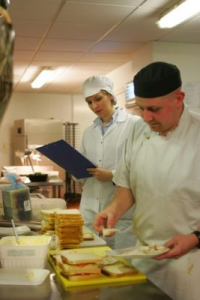 Intermediate Food Hygiene
Intermediate Food Hygiene
Intermediate food hygiene
 The intermediate food hygiene training course is designed for those working in all food businesses at supervisory level. This includes ‘traditional’ supervisors and team leaders, but also anyone who needs an understanding of food hygiene as part of their work.
The intermediate food hygiene training course is designed for those working in all food businesses at supervisory level. This includes ‘traditional’ supervisors and team leaders, but also anyone who needs an understanding of food hygiene as part of their work.
Owners and managers in small to medium sized organisations, depending on the type of food business, may also find that the intermediate food hygiene course provides them with sufficient knowledge to carry out their responsibilities effectively.
Course Syllabus and objectives:
1. Food poisoning.
The expected outcome is that the student knows the symptoms and main causes of food poisoning and is able to:
- Explain what is meant by the terms “food hygiene”, “food poisoning”, “food-borne disease” and “contamination”.
- Describe the symptoms of food poisoning.
- State the causes of food poisoning.
- List sources of bacteria which cause food poisoning and the ways in which bacteria are transferred to foods.
- List the sources of food borne disease and the bacteria concerned.
- Define and give examples of high-risk foods.
2. Bacteriology.
The expected outcome is that the student understands the characteristics of bacteria and their potential to cause disease and spoil food, and is able to:
- Explain what bacteria and other micro-organisms are and where they are to be found.
- Explain the process by which bacteria reproduce and the timescale of that process.
- Describe factors which influence the growth of micro-organisms.
- State the difference between pathogenic and spoilage bacteria.
- Explain what toxins are and why they are dangerous.
- Explain what spores are and their effect on the survival of bacteria.
3. Prevention of Contamination and Food Poisoning.
The expected outcome is that the student understands methods of preventing food poisoning and is able to:
- Explain the role of temperature in the control of bacteria.
- Explain the importance of correct handling, preparation, cooling and processing of food.
- Sate how preservation can prolong the shelf life of food.
- Explain the importance of stock rotation in preventing food poisoning and spoilage.
- Give examples of common food contaminants.
4. Personal Hygiene.
The expected outcome is that the student understands the need for high standards of personal hygiene for food handlers and is able to:
- Explain the importance of personal hygiene in food handling.
- Describe the sources of contamination from injuries, personal clothing or habits and how risks can be eliminated.
- Explain the risks associated with food being handled by carriers of, or sufferers from, food poisoning or food-borne diseases.
- Explain the importance and properties of protective clothing.
- Describe the essential first aid equipment required for food premises.
5. Premises, equipment and pest control.
The expected outcome is that the student recognises the need for high standards of hygiene in food premises and the ways of achieving them, and is able to:
- Explain the importance of fitting out, construction and equipment in food premises to make them suitable.
- Describe the washing facilities which should be provided for food, equipment and food handlers.
- Describe acceptable methods of disposing of waste from food premises.
- Define the term “food pest” Describe the conditions in which the following pests thrive: rodents, birds, insects.
- List the signs of infestation by food pests.
- Describe acceptable methods of controlling pests in food premises.
6. Cleaning and disinfection.
The expected outcome is that the student understands the need for and methods of achieving high standards of cleanliness in food premises, and is able to:
- Explain the difference between cleaning and disinfection.
- Explain the importance of regular, systematic cleaning and disinfection procedures.
- Give examples of acceptable methods of cleaning and disinfection.
- Explain the differences between various chemicals and their effect in good hygiene regimes.
7. Preservation.
Candidates will learn about the different methods of preservation of food including, canning, pickling, smoking, dehydration, Vacuum packing, freezing and chilling, salting or brining, high sugar concentrations, alcohol preserving, smoking and Irradiation.
8. Legislation.
The expected outcome is that the student has an understanding of the requirements of The Food Safety and Hygiene (England) Regulations 2013 and all subsequent amending regulations, and is able to:
- Describe the powers which local authorities have to control the sale of unfit, sub-standard or injurious food.
- Explain the circumstances in which insanitary food premises may be closed.
- State the requirements of the current Regulations, in relation to:
- Construction and cleanliness of premises and equipment.
- Food handlers and their training.
- The handling of food.
- Facilities to be provided in premises.
- The temperatures at which food is stored.
9. Food safety management and HACCP.
- Candidates should have an understanding of how food safety management systems can be used to prevent food poisoning.
- Candidates should understand the procedure for setting up HACCP systems and be able to design their own HACCP plan.
Course length: 3 days.
Qualification achieved: intermediate food hygiene certificate.
Cost: £180 per person + VAT.
We run courses in house or at our training centres in Lincoln and Grimsby. We also run open courses regularly for individuals or businesses needing to train single employees.
Click here to download intermediate food hygiene syllabus.

